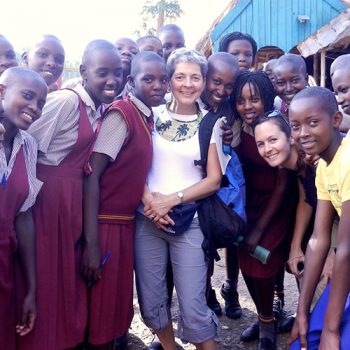When teachers in rural Ghana peer through a gender lens
It is a long journey from Accra to Kumbuyili. In lifestyle, the distance is even greater. The sophistication of Accra, a capital city of millions, is a world away from the traditions of this tiny northern Ghana village. But in at least one respect they are the same — gender inequality afflicts them both.
In Accra, exposure to modernity has shaped that inequality, but in Kumbuyili and other rural Ghanaian villages, gender inequality has its own unique roots. So how can a teachers’ union with headquarters in Accra support women teachers in Kumbuyili? What can be offered that is relevant in rural Ghana that can address school-based gender violence and help girls succeed in school?
The Ghana National Association of Teachers (GNAT) is beginning to find answers to these questions — starting with teachers and schools, and reaching out from there. As part of the “Nkabom” program that also mobilizes communities in support of schools and provides Professional Development (PD) for teachers and school heads, GNAT is now offering gender in-services to teachers, followed up with “Gender Mobilization” gatherings for the whole community, including traditional chiefs, elders and community leaders.
The program revolves around seeing culture through a gender lens. Whose culture? The culture of the village.
Early in the workshops, gender is distinguished from sex (the biological make-up of an individual) and is defined as socially constructed roles assigned to individuals and that affect relationships between men and women. With this definition, workshop participants understand gender as something diverse and changeable, and this leads to the realization that they have the power to make things different, and better. Helena Awurusa, GNAT’s gender officer, describes it as “gender-blind wax removed from their eyes”.
Social structures are explored in terms of perceptions of men, women, girls and boys. For instance, initiation rites for the girl child include Dipo, Bragoro and genital mutilation. Through the sharp focus of a gender lens, it is clear these rites are heavily laden with activities that objectify women and prepare girls for subservience. Similarly, such things as stories, myths, sayings, proverbs, rituals, roles and responsibilities are clearly seen to perpetuate inequality and to stifle the contributions that could otherwise be made by women.
With the clearer vision the gender lens provides, workshop participants are able to move on to practical realities, and make plans to take action.

These gender workshops are not without context and much takes place in advance of them. First, a village is mobilized to take action on behalf of its children and citizens. Then, with support from the Canadian Teachers’Federation’s (CTF) Project Overseas, teachers and school heads begin implementing child-centred active learning methods. Through CTF supported partner forums, mobilized villages meet and often partner with relevant NGOs. It is only after all this has happened — once communities have brought about their own successes, experienced positive change, and established trust in GNAT’s program — that they are asked to take a look at themselves through the gender lens.
The two main parts to GNAT’s gender program for schools, Gender-friendly PD for teachers and Gender Mobilization for the community, are interconnected. The Gender PD results in action plans, implemented over six months, and culminating in a presentation by students to the community during the Community Gender Mobilization workshop. Between the two main activities, schools are revisited to ensure action plans have been carried out, a gender inventory of communities is undertaken, local union and ministry officials are contacted for support, and a courtesy call is made to the chief. This courtesy call is critical as the chief’s support signals to the community the importance of the Gender Mobilization activities.
So how is viewing local life through a gender lens received in these villages?
The chief and elders in some of the villages have pointed out that the Gender Mobilization not only provides a new perspective and understanding, it “touches the hearts of the people”.
Student presentations are a hit the world over, and rural Ghana is no different. When children perform short plays about gender roles in the classroom, about girls’ defilement on the way to school, or about families that keep their girls at home, mothers, fathers, grandmothers and communities peer with avid attention through the gender lens of a child. GNAT Deputy General Secretary Gifty Apanbil, after acting as a facilitator, noted that “as the children were presenting, the chief, his elders and community members all listened intently”. At some of these gatherings, children also present art work that depicts how gender sensitivity provides a safety net for the girl-child. The chief and elders in some of the villages have pointed out that the Gender Mobilization not only provides a new perspective and understanding, it “touches the hearts of the people”. This sets the stage for a deep, frank look at how village culture impacts gender roles and relationships.
The Gender Mobilization sessions are only a beginning. Just as teachers implement action plans following the Gender PD sessions, so too do communities implement their plans following Gender Mobilization. These plans outline the needs the activities will address, who will work on them, methods that will be used, start and end dates, and indicators of success. Some chiefs have their own plans as well. One stated that he will now circulate the village to locate girls and boys not in school, and will ask parents why their child is not attending. Gender Mobilized communities in rural Ghana are definitely on the move. As Helena Awurusa tells participants, “During these sessions, you have planted some flowers. Take care of them.” She also reminds teachers they are role models: “The children are watching. When you teach them well, they know. Be the lamp.”


